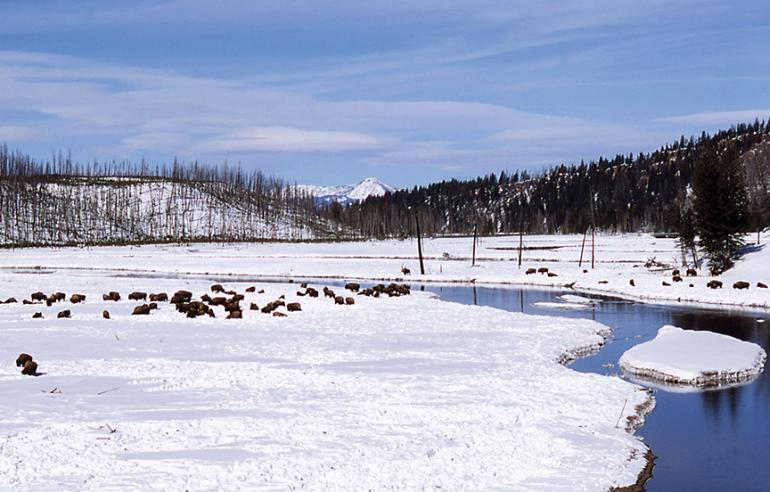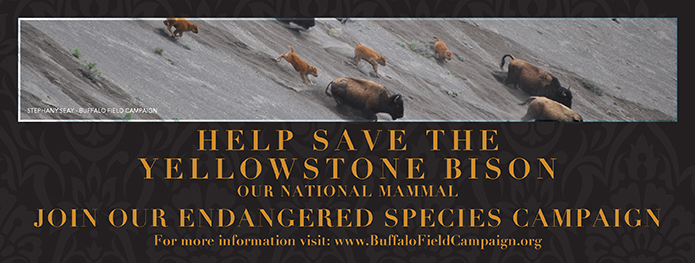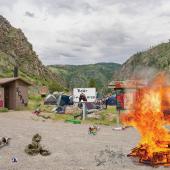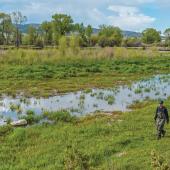Bison Betterment
Many years ago on a winter drive through Yellowstone Park to Cooke City, I viewed a herd of buffalo working their way through the deep snow of the Lamar Valley. I remember thinking what a magnificent animal the buffalo was—"bison" to you biological sophisticates—that it could sustain a whole culture for several centuries. The snow-covered heads and the efficient unison in which the herd traveled kept me spellbound.
Prior to the establishment of extensive snowmobile trails throughout Yellowstone that now provide exit corridors for the beast, the buffalo moved en masse through an unbroken snowfield much like a snowplow: the large bulls up front forming a semi-circle, their heads swinging from side to side, moving the snow for the cows and calves to pass through more easily.
For those creatures to prevail in such a harsh environment is not only a statement of their genetic fortitude, but also one of the co-evolution between a species and a tough, sustainable nomadic culture. This view was harshly criticized by economist Dr. Richard Stroup, a retired professor at MSU, who proposed that the lack of private-property rights between Native Americans was cause for the near-extinction of the buffalo. Calling horseshit on the theory, I read an excerpt describing several days of white frontiersmen and European dignitaries shooting buffalo from trains, taking nothing more than an occasional hide and leaving thousands of carcasses in their wake.
It is that same lack of respect for life that now characterizes the shooting of buffalo from Yellowstone Park, because of unproven scientific claims of brucellosis transmission and overstated, poorly thought-out government policies and regulation. Winters have passed without a viable solution, more than a thousand buffalo were slaughtered, and once again government agencies hope to have a workable solution in place by next winter.
The fundamental problem is one of cultural perspective: the culture being property-rights-obsessed white Americans, the perspective being that the buffalo are a problem. Government intervention has only bureaucratized a cultural dilemma.
Juxtapose this dominant perspective with one that is utilitarian in nature: that the buffalo are not a problem, but rather, a biological resource. If we keep looking at the buffalo as a problem, they will be treated as such, and we’ll be stuck with the haphazard solutions like the ones we currently have. We will lay waste to potential.
On the other hand, if it’s possible to alter our perspective to reflect the biological and economic value of the buffalo as a resource, a whole other realm of possibilities emerge. The species has value as a resource and the Yellowstone herd contributes to the foundation of genetic diversity. Without an ever-expanding genetic pool, the species is much like a monoculture, susceptible to disease and other threats to genetic viability, putting it at risk of extinction. Doesn’t it make more sense to treat the Yellowstone buffalo herd as a resource rather than a problem? If so, then let’s act that way and work toward a solution that reflects and enhances the value of the resource.
There is evident value in establishing additional buffalo herds elsewhere. Doing so will provide a diverse, viable population which will evolve genetically due to environmental influences. More tangible benefits will be realized as well, such as the preservation of immunities to brucellosis and other ungulate diseases.
Although Ted Turner has taken heat for being an atypical stockman on his Montana ranches, you have to give him credit for recognizing the value of raising buffalo. While the buffalo come with their own share of management problems, the fact of the matter is, they have been acknowledged as a resource, and suitable management practices will eventually emerge.
Plains Indians were sustained by buffalo herds for centuries, and the animal is still a unique and necessary cultural resource. The buffalo are of value to these cultures, and it is only state and federal policies and practices that transform what one culture values as a resource into what another designates as a problem.
The simplest, most straightforward solution is one that has been proposed by the Inter Tribal Bison Cooperative (ITBC). Since 1991 the ITBC has proposed taking live bison from Yellowstone, quarantining them on tribal lands, and then distributing them to members of the ITBC in order to establish herds. Yet, both state and federal agencies have refused to seriously consider the proposal. The logistics and consequences of the ITBC proposal are far less complex than what is occurring now under the direction of government agencies.
Yellowstone Park bison are a public resource mandated to be managed for the public good. You can’t help but wonder: are buffalo the problem, or are we creating the problem by allowing private-property rights, special-interest groups, and state/federal policies to complicate a situation beyond resolution?
The entire endangered-species issue is representative of the perspective that what is wild in nature is problematic. Adherence to this perspective is the root of development-sanctioned extinctions. Favoring economic expansion and development over species preservation systematically eliminates the very resource foundations of future industry potential.
The controversy generated over a creature as large and visible as the American Bison can potentially help shift American society and policy-makers’ perspective. It will take that fundamental shift in thinking to alter the course of development from one of conflict to one of sustainable usage. If not, we can expect to continue to see not only ineffective conflict resolution, but also the eventual degradation and extinction of some of the earth’s most valuable biological resources. Once again, the world is watching and we’re staging a three-ring-circus right here in our backyard. We can do better than that: give the buffalo to the ITBC. Give them to someone who views them as the indispensable resource they are.
R. Ladzinski is a freelance writer and realtor with a conservationist bent in search of the perfect powder turn (and peace on Earth).














